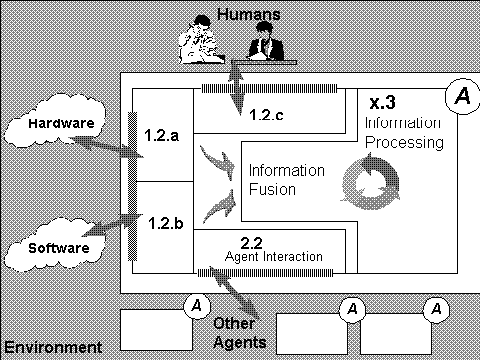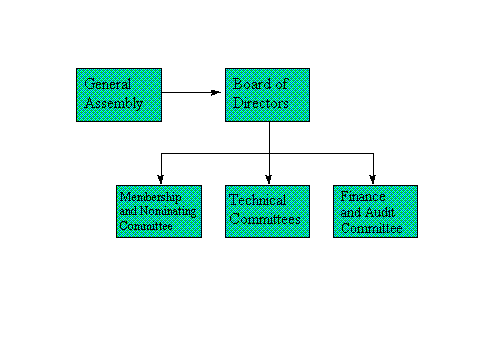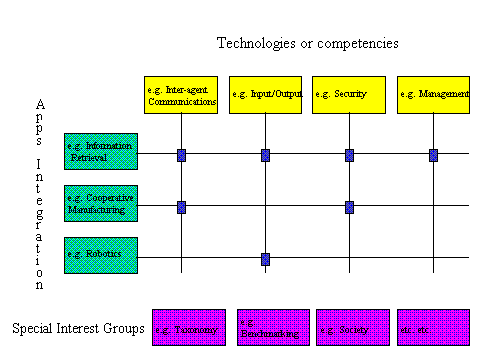
Helping agent technologies get
across to the market place
Leonardo Chiariglione
CSELT - Torino - Italy
Even though it did not get it yet to the
headlines of popular newspapers, as its more famous cousin
multimedia, the word agent has become fashionable in last few
years and a number of applications that would be made possible by
agent technologies have been identified.
A partial list is:
User Assistant (e.g. personal email filter/sorter, scheduler)
Information Retrieval (e.g. directory service, information brokerage)
Entertainment (e.g. avatars, games, video production)
Service Management (e.g. information provision, electronic commerce)
Business Process Management (e.g. Network Management, Workflow Management)
Manufacturing Management (e.g. Virtual Factory Management, Factory Manufacturing Robots)
Service Robotics (e.g. Office Delivery Robots, House Cleaning Robots)
Cooperative Tasks Management (e.g. High Level Task Management)
Most of the listed applications already exist. The new features that agents will bring to existing applications are possible because agents is endowed with the capability, among others, of
operating without external intervention
interacting with humans or other agents
perceiving the environment and responding to changes in it in a timely fashion
taking the initiative to achieve some goal
moving in the environment
being a continuously running process
adapting to changes in the environment
All this looks very exciting. Why have these
features not been introduced yet?
Agents are a field at different stages of
development. In some areas agent technologies are at an infant
stage while in others they are already approaching maturity, as
demonstrated by the fact that some products that claim to (and
sometimes do) use agent technologies have begun to appear.
In most cases some form of standardisation is needed to transform
agent technologies into products, applications or services that
are widely deployed. Standardisation means, however, three
different things to different people:
Formal standardisation. In principle everybody agrees that this is the best solution is important, however, there is the reluctance on the part of many to commit resources in processes that are perceived as being oppressed by bureaucracy, passive, driven by extreme search of consensus and sometimes poorly managed.
Industry standardisation. This happens when one or a handful of major players produce a specification. These may be successful because of the sheer weight of the players involved or may be antagonised by other players who fear that an advantage is gained by others because a particular technology is unfamiliar, owned by others or based on business models not shared by others.
Industry consortia standardisation. They have provided a fast development process, as in the case of the ATM Forum.
The case of applications made possible by
standardised agent technologies, however, is more complex because
what needs to be specified is not just a technology for one
community (as in the case of the ATM Forum) but generic
technologies for different communities and not just independent
technologies but a set of technologies that can be integrated by
different communities to make complex systems with a high degree
of interoperability across applications.
Generic technologies yield three major benefits. They are
enabling because some products and applications become possible
only when common standards exist, technological because economies
of scale accelerate the deployment of applications and synergetic
because different applications have a higher level of
interoperability.
This approach has been successfully adopted in MPEG, where
generic tools for audio-visual coding were specified by all
industries concerned so that suitable assemblies could satisfy
their requirements and in DAVIC where generic tools were
specified by all industries concerned so that different systems
could be implemented with a high degree of interoperability.
The Foundation for Intelligent Physical Agents (FIPA) is an international non-profit association of companies and organisations which agree to share efforts to produce specifications of generic agent technologies with the following features:
timely
internationally agreed
usable across a large number of applications
yielding a high level of interoperability across applications.
To achieve these statutory goals the following principles must be adhered to:
The goals are realised through the open collaboration of all players in the field
As a rule FIPA selects and adapts existing technologies and only occasionally develops its own technologies
Specifications must be produced before industries make commitment
As a rule systems are not be specified but generic technologies usable in different systems, only the external behaviour and not the internal working
When a functionality needs a technology it is highly desirable that the technology be unique
Technologies needed to support functionalities must be relocatable
FIPA specifies tools that can then be assembled to provide systems of practical interest, however, it is the responsibility of the subsystem integrator to ensure that the overall system is fit for purpose and complies with all relevant regulatory requirements.
The FIPA specification development is based on a workplan, organised in work items. Each work item identifies a date of completion and a list of subsystems whose specification is believed to feasible by the agreed date and whose enabling technology is believed to become available for use by around the date of work item completion.
FIPA specifications are of two kinds: normative and informative. A specification is normative when it mandates the behaviour of a subsystem to ensure interoperability with other FIPA-specified subsystems. A specification is informative when its aim is to provide guidance to industry on some particular aspects of a subsystem
FIPA Members are companies, organisations and governmental institutions. They pay yearly membership fees, have the right to vote on matters that require voting and are allowed to join the technical committees developing technical specifications
The FIPA initiative has aroused immediate
interest. A first meeting called in April was attended by
representatives of 25 companies (5 of which universities). A
second meeting called in June was attended by 50 companies (10 of
which universities). Besides agreeing on the basic principles
above the group developed a framework, a list of applications, a
list of requirements and a list of technologies whose
standardisation is needed to deploy the applications.
The figure below is an attempt at representing an agent and the
four different components in the environment with which the agent
may interact: Humans, other Agents, other non-agent Software
(SW), and the Physical World (PW).

The drawing points to Human<->Agent and Agent<->Agent interaction to the two critical areas for agent technology standardisation. The features of these two areas are given in the table below.
| Interaction | Examples | Agent Characteristics | Intrinsic Requirements | Extrinsic Requirements |
| Human<-> Agent | Mono/Multi-modal Input/Output | AdaptiveExtensibleRational | Knowledge/Information Representation & Processing | PerceptionGeneration |
| Agent<-> Agent | Agent Interaction Language | Reactive | Information Fusion | Communication (point-to-point, broadcast) |
An Agent Basic Capability (ABC) List has been produced. This is subdivided in 4 parts: single agents, cooperating agents, society of agents and miscellanea.
Single agents deals with resource for execution, interaction (with hardware, software and humans) and cognition.
Cooperating agents (a few of them) deals with resources for communication, interaction (message types/communication primitives, message content and composition of messages) and cognition.
Society of agents (many of them) deals with resources for agent societies (central services and agent libraries), interaction within a society (standard libraries of protocols, security and cognition)
Miscellanea deals with specification of minimal class library and reference libraries.
At the procedural level the next step is the formal establishment of FIPA as a non-profit organisation in Switzerland governed by the following organisational chart:

At the technical level the next step is the
holding of the third FIPA meeting on 7-11 October in Tokyo,
Japan, hosted by by NHK
(Japan Broadcasting Corporation), at
their Science
and Technical Research Laboratories. For
that meeting everybody is invited to submit proposals of
applications with precise identification of which technologies
need standardisation. Different applications will be ranked and
two-three retained. At the end of the Tokyo meeting a Call for
Proposals will be issued where proposals of technologies
satisfying specified requirements in response to the needs of the
selected applications will be requested from anybody,
irrespective of his FIPA membership status. Submissions in
response to the Call for Proposals will be considered at the 4th
meeting in February 1997. The first set of specification will be
published at the end of 1997
The October 1996 meeting will also see a first implementation of
the organisation of technical work. Different groups will be made
responsible of the development of generic technologies, while
other groups will make sure that the generic technologies so
developed can be integrated to fit the needs of the applications
identified. Special Interest Groups may also be established to
entertain discussions about future new fields of activity as a
result of more agent technologies reaching maturity. The figure
below depicts a possible organisation.

Further information can be found a http://www.cselt.it/fipa